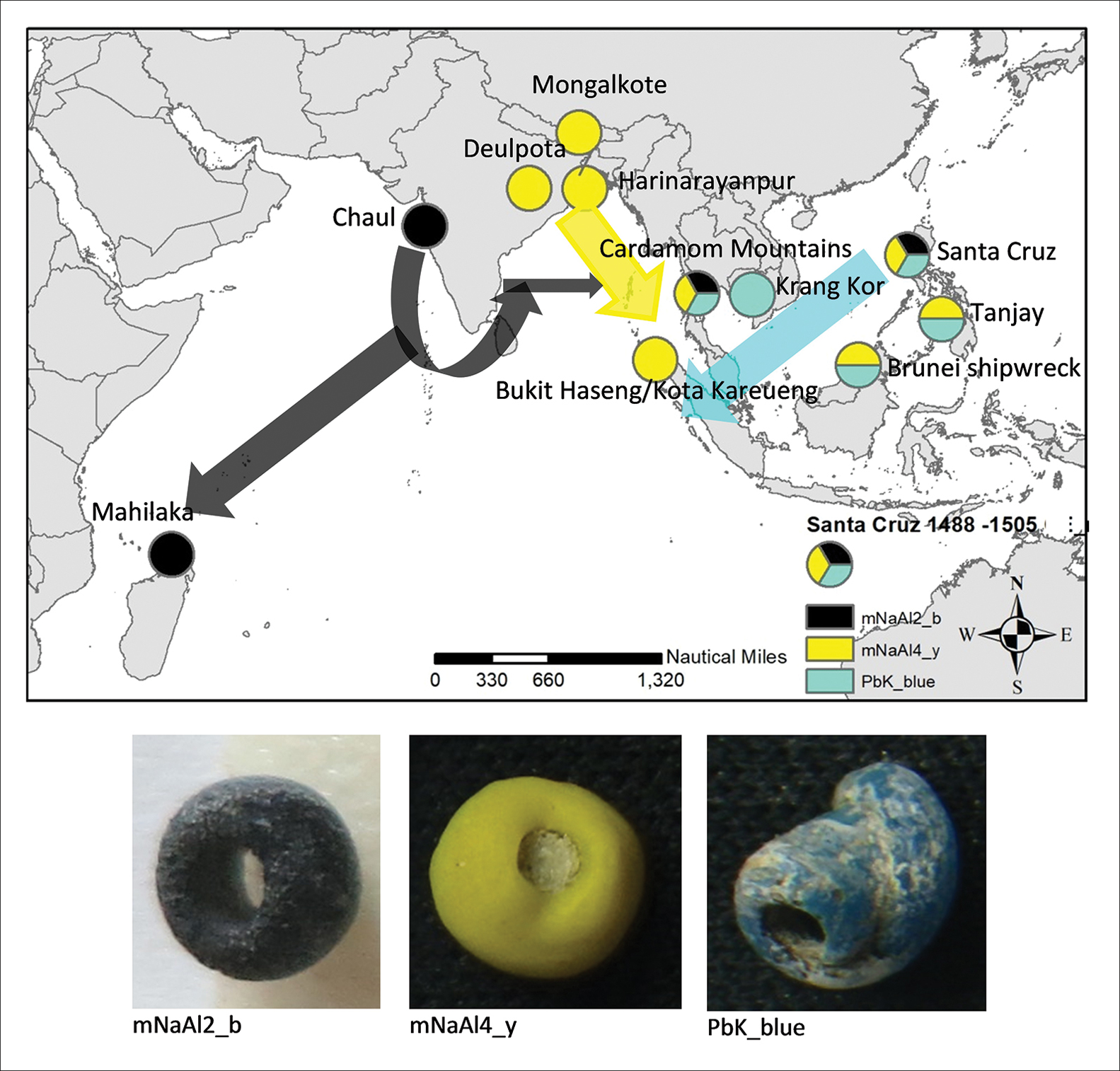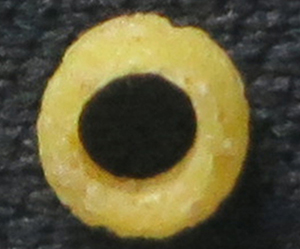This article merges regionalised studies on glass material in the Indian Ocean world, a geographic area expanding from East Africa, across the Middle East, Asia and Southeast Asia, to the western Pacific Ocean. The archaeological sites discussed here are shipwrecks. The date ranges of the sites are deduced from the cargo artefact assemblages, which probably span both the time the ship sailed and its wrecking. The morphological and compositional analysis of 41, 26 and 18 glass beads from the shipwrecks Pandanan (AD 1460–1487), Santa Cruz (AD 1488–1505) and Royal Captain Shoal wreck 2 (AD 1573–1620), respectively, has added evidence to previously held hypotheses on drawn soda-alumina and wound lead-potash glass beads. The morphological analysis includes observation of colour, size and the manufacturing style of glass beads by the direction of striations in relation to the bead bore: drawn beads are parallel and wound beads are perpendicular. The compositional analysis was performed using laser ablation-inductively coupled plasma-mass spectrometry (LA-ICP-MS).
Compositional analysis on archaeological glass has produced multiple groups of soda-alumina glass (Dussubieux et al. Reference Dussubieux, Gratuze and Blet-Lemarquand2010; Dussubieux & Gratuze Reference Dussubieux, Gratuze and Janssens2013) and has recently identified two groups of lead-potash glass (Carter et al. Reference Carter, Dussubieux, Polkinghorne and Pottier2019). Of relevance to this study are the soda-alumina group 2 and group 4 glass, and the later of the two groups of lead-potash glass. The glass beads from the three shipwrecks were identified by comparing their LA-ICP-MS and statistical analysis results to known datasets of soda-alumina and lead-potash glass sub-types (Craig & Dussubieux in press).
Three maps illustrate the distribution of Indian Ocean world glass identified from the shipwrecks, during the periods AD 1460–1487, AD 1488–1505 and AD 1573–1620 (Figures 1, 2 & 3). The refined chronology and distribution of mid-fifteenth to mid-seventeenth century Indian Ocean world glass indicates three broad directions of exchange flow over the three periods. In the two earlier periods, spanning AD 1460 to 1505, drawn red and black soda-alumina (group 2) glass was made in an unknown location and exchanged initially eastwards from Chaul (Robertshaw et al. Reference Robertshaw2006, Reference Robertshaw2010; Dussubieux et al. Reference Dussubieux2008; Wood Reference Wood2011, Reference Wood2016, Reference Wood and Ludden2019; Carter et al. Reference Carter, Dussubieux and Beavan2016; Grave et al. Reference Grave2019; Shewan et al. Reference Shewan2020; Dussubieux & Wood Reference Dussubieux, Wood, Kanungo and Dussubieux2021; Craig & Dussubieux in press). During the second period (AD 1488–1505), lead-potash glass re-entered the Indian Ocean world market from the east—likely from China—in the form of wound blue beads (Tamura Reference Tamura2015; Carter et al. Reference Carter, Dussubieux and Beavan2016; Carter et al. Reference Carter, Dussubieux, Polkinghorne and Pottier2019; Craig & Dussubieux in press). At the same time, a yellow variant of the soda-alumina (group 4) glass was shipped eastward from north-east India, possibly as raw glass to workshops in Southeast Asia, formed into different products and cross-exchanged westward (Gratuze Reference Gratuze2001; Huet Reference Huet and L'hour2001; Dussubieux Reference Dussubieux, Perret and Surachman2009; Carter Reference Carter2016; Carter et al. Reference Carter, Dussubieux and Beavan2016; Craig & Dussubieux in press). This yellow variant of soda-alumina (group 4) glass also raises a complicating factor. Specifically, glass beads discovered in an open burial in the Cardamom Mountains (in which human remains were dated to cal AD 1430–1465 (432±26 BP; GU31833; Beavan et al. Reference Beavan, Hamilton, Sokha and Sayle2015) match those from the later Santa Cruz wreck, but the beads may have been placed later (due to the open nature of the grave). This would explain the presence of later beads in an earlier burial. By the third period (AD 1573–1620), lead-potash glass had expanded into multiple monochrome colours in the eastern Indian Ocean world and had eclipsed drawn soda-alumina glass entirely (Carter et al. Reference Carter, Dussubieux and Beavan2016; Wood Reference Wood2016, Reference Wood and Ludden2019; Carter et al. Reference Carter, Dussubieux, Polkinghorne and Pottier2019; Craig & Dussubieux in press).

Figure 1. Map showing the distribution of Indian Ocean world glass identified from the Pandanan shipwreck during the period AD 1460–1487: hMg = drawn high-magnesium black; mNaAl2_b = drawn soda-alumina group 2 black; mNaAl2_rs = drawn soda-alumina group 2 red standard (length 1–4mm); mNaAl2_rl = drawn soda-alumina group 2 red long (length 4.5–15mm). Descriptors ‘standard’ and ‘long’ are based on measurements defined by a bead ratio formula (Wood Reference Wood2011: 70 & tabs 1–2) (map and photographs by the author).

Figure 2. Map showing distribution of Indian Ocean world glass identified from the Santa Cruz shipwreck during the period AD 1488–1505: mNaAl2_b = drawn soda-alumina group 2 black; mNaAl4_y = soda-alumina group 4 yellow; PbK_blue = wound lead-potash blue (map and photographs by the author).

Figure 3. Map showing distribution of Indian Ocean world glass identified from the Royal Captain Shoal wreck 2 during the period AD 1573–1620: PbK_tpurple = wound lead-potash transparent purple; PbK_orange = wound lead-potash orange; Pbk_red = wound lead-potash red; PbK_white = wound lead-potash white; PbK_yellow = wound lead-potash yellow (map and photographs by the author).
When refined to shorter periods of exchange, morphological and compositional analyses have increased our understanding of the chronology and distribution of mid-fifteenth to mid-seventeenth century glass.
Acknowledgements
The author thanks the National Museum of the Philippines, Jeremy Barns, Angel Baptiste, Mary Jane Bolunia, Sheldon Clyde Jago-on, Bobby Orillaneda, Nida Curvas and Eusebio Dizon. Thanks also to Laure Dussubieux in the Elemental Analysis Laboratory of the Chicago Field Museum, Brandon Taylor in the McGill Geographic Information Centre and the anonymous peer reviewers.
Funding statement
Fieldwork was supported by the Society for Nautical Research, Brasenose College and Oxford University Meyerstein. Laboratory analysis was supported by the National Science Foundation and a Bruce and Barbara Trigger Award awarded by the Anthropology Department at McGill University. Statistical interpretation was supported by a MITACS Research Training Award. Writing and mapping was supported by the Social Science and Research Council of Canada MCRI and a McGill University Award of Excellence.






